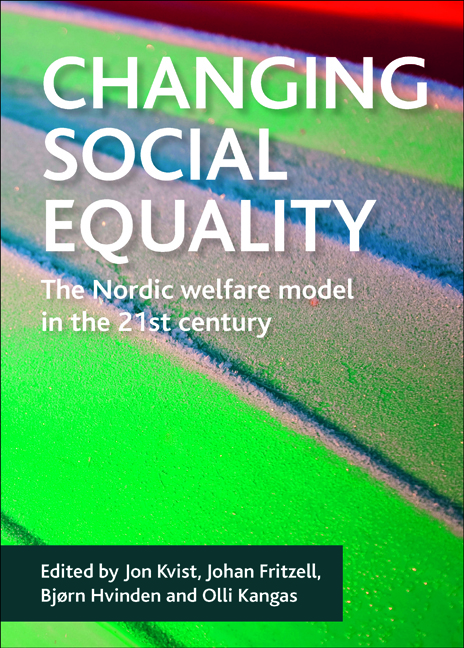Book contents
- Frontmatter
- Contents
- List of tables and figures
- Notes on contributors
- Acknowledgements
- one Changing social inequality and the Nordic welfare model
- two Anti-immigration attitudes, support for redistribution and party choice in Europe
- three Do we all (dis)like the same welfare state? Configurations of public support for the welfare state in comparative perspective
- four Eroding minimum income protection in the Nordic countries? Reassessing the Nordic model of social assistance
- five Equality in the social service state: Nordic childcare models in comparative perspective
- six Welfare state institutions, unemployment and poverty: comparative analysis of unemployment benefits and labour market participation in 15 European Union countries
- seven Social inequalities in health: the Nordic welfare state in a comparative context
- eight Income inequality and poverty: do the Nordic countries still constitute a family of their own?
- nine Is immigration challenging the economic sustainability of the Nordic welfare model?
- ten Nordic responses to rising inequalities: still pursuing a distinct path or joining the rest?
- Index
one - Changing social inequality and the Nordic welfare model
Published online by Cambridge University Press: 01 September 2022
- Frontmatter
- Contents
- List of tables and figures
- Notes on contributors
- Acknowledgements
- one Changing social inequality and the Nordic welfare model
- two Anti-immigration attitudes, support for redistribution and party choice in Europe
- three Do we all (dis)like the same welfare state? Configurations of public support for the welfare state in comparative perspective
- four Eroding minimum income protection in the Nordic countries? Reassessing the Nordic model of social assistance
- five Equality in the social service state: Nordic childcare models in comparative perspective
- six Welfare state institutions, unemployment and poverty: comparative analysis of unemployment benefits and labour market participation in 15 European Union countries
- seven Social inequalities in health: the Nordic welfare state in a comparative context
- eight Income inequality and poverty: do the Nordic countries still constitute a family of their own?
- nine Is immigration challenging the economic sustainability of the Nordic welfare model?
- ten Nordic responses to rising inequalities: still pursuing a distinct path or joining the rest?
- Index
Summary
Introduction: inequality on the rise?
Nordic mass media regularly announce the end of equality in the Nordic countries – is it a reality or merely another example of journalistic dramatisation and myth-building? In this book we aim to clarify in what ways equality has actually characterised the Nordic countries and to what extent we now find less equality in earnings and disposable incomes, participation in paid employment and informal care, social participation, educational achievements and health and well-being. Assuming that we can confirm that there has been a shift away from equality, we should then be able to point to factors and mechanisms that have sustained a high degree of equality earlier on and similarly, to the factors and mechanisms that are now driving the Nordic countries toward more inequality.
Why is Nordic social equality changing? We take as our starting point the international trend of growing income inequalities. Although countries have become richer, at least up until the 2008 financial crisis (Atkinson and Morelli, 2010), affluence appears now to be more unequally divided, and the gap between rich and poor is widening. Whereas many countries have experienced different degrees and patterns of change in their distribution of income over the last three decades (see, for example, Atkinson, 2008; ILO, 2008; Kenworthy, 2011; OECD, 2008), we also find several commonalities. While a decreasing, or at least stable, degree of income inequality was the norm in the Western world for most of the 20th century, in the 1980s that norm suddenly started to change. The general picture has since become one of growing income inequalities.
But it is not only the overall trend of growing inequalities that is of interest. We now have ample evidence that the shift in trends has been particularly evident at the upper end of income distribution. The prime example is the US: in 2007, the year before the latest financial crisis, the share of the total income going to the top 1 per cent of the population was estimated to be around 23-24 per cent, or close to one quarter of the total (Reich, 2010). Interestingly, this share is matched only by that in 1928. Thus two general and difficult questions emerge. First, what are the causes of this upsurge of inequality?
- Type
- Chapter
- Information
- Changing Social EqualityThe Nordic Welfare Model in the 21st Century, pp. 1 - 22Publisher: Bristol University PressPrint publication year: 2011



